| |
NANO : learner |
MICRO : class |
MESO : schools |
MACRO : system |
1. Language and languages
Operational dimension |
|
|
|
|
| |
| FOR |
- Language control (standards, variations, registers)
- Metalinguistics
- Flexible plurilingualism (dealing with a plurilingual repertoire) |
|
| THROUGH |
- Discursive, reflexive skills
- Learning with others |
|
| EXAMPLE |
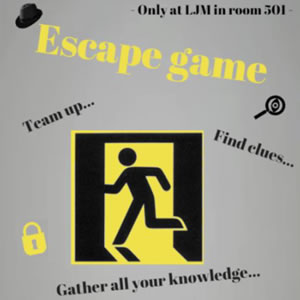 Example 1: Escape game Example 1: Escape game
Students create an adventure game in which players must collectively solve a puzzle in languages and science in order to get out of a room. They have one hour! This game, made available to partner schools and parents, combines oral and written comprehension activities.
|
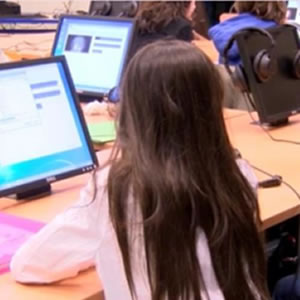 Example 2: Pairwork in Arabic Example 2: Pairwork in Arabic
The lesson has two stages:
- pupils ‘discover’authentic documents about the environment based on two case studies in the Arab world;
- work in pairs, where the pupils record an audio commentary independently and collaboratively.
|
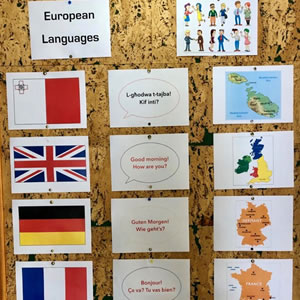 Example 3: Multilingual display - Malta Example 3: Multilingual display - Malta
Developing language skills also means displaying all the languages offered in a school. The multilingual school display helps to integrate languages into the school landscape and to motivate students.
|
| FOR |
- Written and oral receptive strategies
- Writing and speaking strategies
- Crosslinguistic skills (intercomprehension)
- Pluriliteracy |
|
| THROUGH |
- Multimodal, digital skills
- Sense and motivation |
|
| EXAMPLES |
 Example 1: Personal alphabet book Example 1: Personal alphabet book
Each student draws up a list of words and expressions in at least two languages (language of schooling, family languages, foreign or regional languages, etc., which they use at school (class instructions, disciplinary literacies, communication from the school, etc.).
Collège de la Binquenais, Rennes, France
|
 Example 2: Team teaching Example 2: Team teaching
Co-teaching situations gave pupils the opportunity to present several monuments in art history and English class by working on video dubbing. They were able to develop skills in languages and art history.
Lycée Pasteur, Besançon, France
|
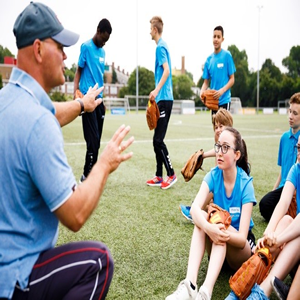 Example 3: Communication in all subjects Example 3: Communication in all subjects
Language plays a central role in all learning. That is the reason why all teachers should become communication experts. This includes not only the linguistic dimension of every subject, it also means developing skills to help students to communicate and being able to create a whole communication plan for a project. Two proposals might help to achieve these goals: the promotion of CLIL and the development of school exchange programmes in all subjects.
CLIL Physical Education lesson at a Dutch secondary school – Baseball in English.
|
| FOR |
- Language(s) of schooling and academic languages
- School code and home languages |
|
| THROUGH |
- Friendly school climate
- Self fulfilment, self esteem |
|
| EXAMPLES |
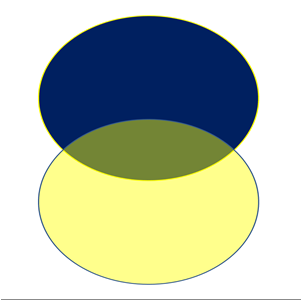 Example 1: Social cohesion through languages Example 1: Social cohesion through languages
In this school, where half of the pupils are Polish, the linguistic dimension is now taken into account in all educational activities (classes, projects, mobility, cultural events, etc.) and in the bilingual communication of the school. Setting up school communication in all the languages of the school community contributes to social cohesion.
Adam Mickiewicz Gimnasium, secondary school for the Polish minority students in Vilnius, Lithuania
|
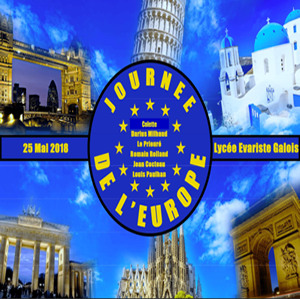 Example 2: European Day Example 2: European Day
Supported by networking, the mediation of resources and expert support, this experiment, in the Sartrouville high school aims to develop disciplinary interaction and to promote the link between high schools in a context of cultural openness. This day aims to develop linguistic diversity with workshops presenting among others the richness of interculturality around European customs, Arab-Andalusian culture and an introduction to Romanian.
Lycée Evariste Gallois, Sartrouville, France |
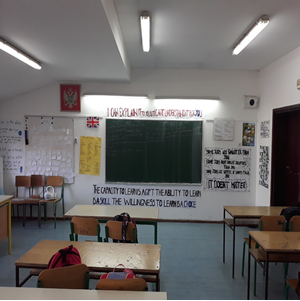 Example 3: Using classroom walls for long term communication Example 3: Using classroom walls for long term communication
Language classrooms are the place to express values, share messages and communicate with students. Communication on the walls of the classroom may contain grammar rules or thematic vocabulary that evolves according to course objectives. However, it is often much more interesting to use the walls for a long-term communication, for example through proverbs, quotes or phrases of encouragement.
English classroom in Montenegro
|
| FOR |
- Managing one’s plurilingual and multicultural repertoire as a global language system |
|
| THROUGH |
- Plurilingual skills
- Feeling of language safety |
|
| EXAMPLES |
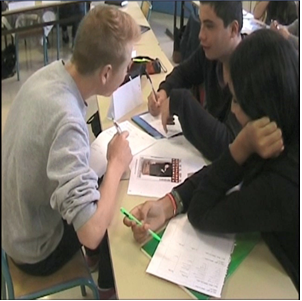 Example 1: Eurolanguages Example 1: Eurolanguages
In order to reinforce the students' exposure to all the languages taught in the school, this school has set up an hour of trilingual teaching (German, English, Spanish) around intercultural mediation activities and a plurilingual wikiradio in conjunction with the university. This approach develops the language awareness of both the students and the teachers.
Lycée Victor et Hélène Basch, Rennes, France
|
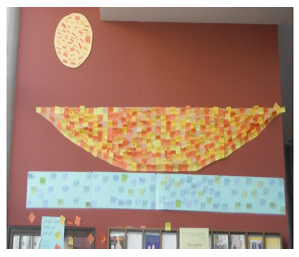 Example 2: Language odyssey Example 2: Language odyssey
The realization of an artistic and linguistic project from a group of allophone pupils for an exhibition presented during the "European Heritage Days". The project aims to work on the lexical field of travel and then to translate it into the languages of the allophone pupils (English, German, Spanish, Polish, Italian, Turkish, Arabic, Tamil, Albanian, Russian, Japanese, Catalan, Chinese, Greek, Portuguese, etc.).
Collège international de l’esplanade, Strasbourg, France
|
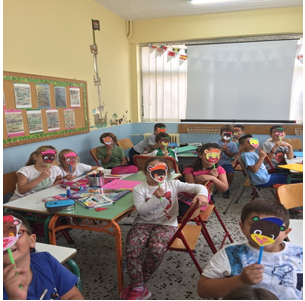 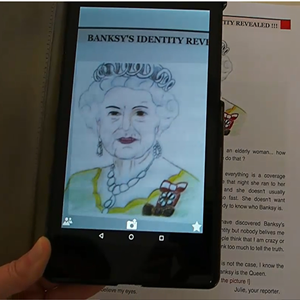 Example 3: Identities Example 3: Identities
Learning a foreign language means expanding your identity. It is often recommended to use masks, class mascots, marionettes or even new names to help young learners dive into a new culture. This distancing makes it easier to compare languages and develop a global language awareness. Writing and speaking texts for others, such as audio-guides or augmented reality story telling for example can have the same function for older learners. This language awareness should then be transferred to other subjects such as literature, physical education, sciences, etc.
Primary school in Greece / Secondary school in France
|
|
2. Valuing languages
Ethical dimension |
|
|
|
|
| |
| FOR |
- Towards minority languages and L1
- Towards modern languages and language of schooling |
|
| THROUGH |
- Language awareness /awakening and interest in learning languages
- Responsibility, sense of belonging, taking initiative |
|
| EXAMPLES |
 Example 1: Convergence Example 1: Convergence
By bringing together numerous isolated actions in languages (e-twinning project, Eurolingua competition, school exchanges) and by selecting which language course contents are taught in, this high school has made all the actors involved responsible for the diversity of languages and cultures.
Seebacher Gymnasium, Graz, Austria |
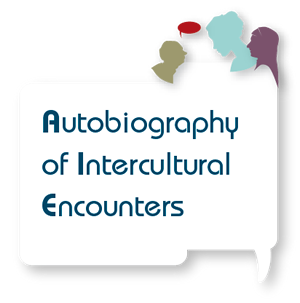 Example 2: Diversity Example 2: Diversity
Linguistic diversity is an asset and a source of wealth for all students. Teachers can rely on this approach to:
- enable all pupils to become aware of this diversity;
- promote the languages spoken by the children in school to show them that they are recognized in their identity;
- take advantage of the experiences of encounters with forms of otherness;
- explain to parents the meaning of this linguistic openness.
https://www.coe.int/en/web/autobiography-intercultural-encounters
|
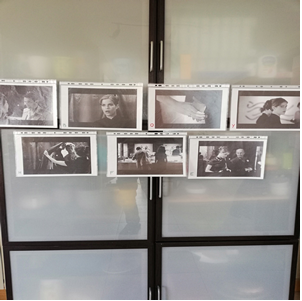 Example 3: The gallery principle – moving towards the target language Example 3: The gallery principle – moving towards the target language
The principle of the gallery is to use all the walls of the classroom to exhibit documents. The document does not go to the student waiting at the table but the student gets up and goes through the classroom to discover the class documents. This worksvery well for example, when the medium is a film of which the teacher has displayed freeze frames all over the classroom. The student then chooses his own itinerary to discover the images and reconstruct the plot of the film. It also works with the sentences of a text, press titles, caricatures or images related to the same theme. Each time, the student moves to reconstruct the meaning. The students can also work in groups which leads to a negotiation of meaning. It is important for the teacher to explain to students that moving promotes memorization so that students become more aware that by learning a language they become ambassadors who must be able to deepen and share their skills.
Pictures from the short film Kunstgriff
|
| FOR |
- Assessing language profiles
- Recognizing plurilingual repertoires |
|
| THROUGH |
- Proficiency and evaluation : evaluation goals, evaluation to learn, to understand, to measure learning
- Self-esteem and feeling of fairness |
|
| EXAMPLES |
 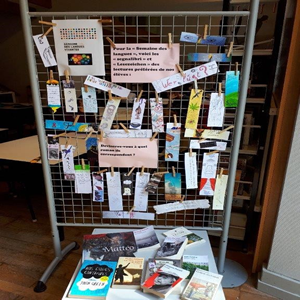 Example 1: Bookmark and dictogloss Example 1: Bookmark and dictogloss
The principle of the bookmark is to ask students to complete their bookmark after a long read. A reading is validated if other students recognize the work read from the bookmark. The principle of the dictogloss is to read a story several times to the students and ask them to report it in groups using their notes. Process validation is the ability of students to mediate the initial content from individual note taking and collective content negotiation.
Foto – Lycée Pasteur, Besançon, France
|
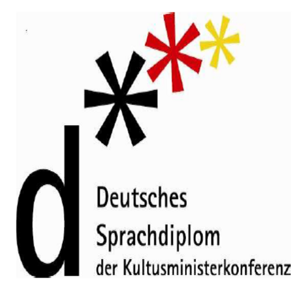 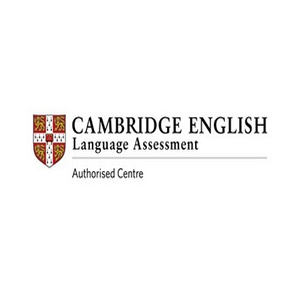 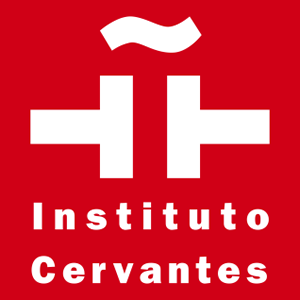 Example 2: Language certifications Example 2: Language certifications
Language certifications play a vital role in motivating students and valuing intermediate achievements. Launched in 2005 in France, there are three certifications in the field of modern languages.They concern different audiences depending on the language. For each of them, the pupils take oral and written tests.
|
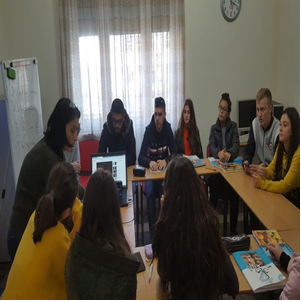 Example 3: Language certificate for mobility - Durrës – Albania Example 3: Language certificate for mobility - Durrës – Albania
More than any other subject, cooperation plays a vital role in language learning and in the validation of proficiency levels. Here a group of B2 students from the Alliance Française in Durrës plans to continue their studies abroad and prepare the French-language studies diploma (Diplôme d'études en langue française, DELF) / the advanced French-language diplôme (Diplôme approfondi de langue française, DALF).
|
| FOR |
- Bringing together individual aims and collective goals
- High standing of school projects and structures |
|
| THROUGH |
- Safe language environment
- Respect and trust towards adults
- Equal opportunities |
|
| EXAMPLES |
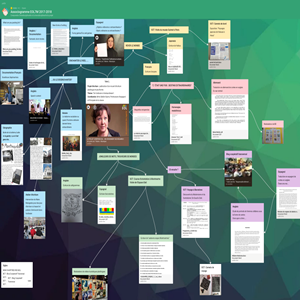 Example 1: Writing and publishing project Example 1: Writing and publishing project
Originating from the needs of students and the desire of the school management to create an appetite for literary studies, this school has developed a global school policy by placing languages at the heart of learning. The team has developed a literary itinerary that ranges from creative writing to publishing and the selling of a collection.
Lycée des Sept Mares, Maurepas, France |
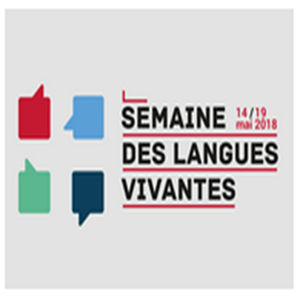 Example 2: Language week Example 2: Language week
During this national event, the school organised new language workshops, a European meal and the final of a game created in 4 languages by the 14 years old pupils in an interdisciplinary project: "The European Union, space of unity and diversity".
Collège Henri Matisse, Linselles, France |
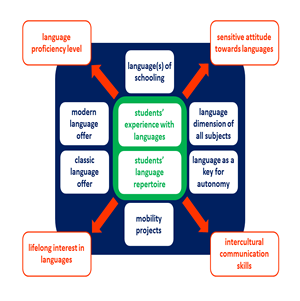 Example 3: Common vision on language matters Example 3: Common vision on language matters
Setting up a school language policy requires that the whole team shares the same vision of the role of languages in education. This simplified diagram shows a few key points that should be at the centre of reflection within the team as well as with students. This work should lead to a real school language plan.
|
| FOR |
- Against hierarchy between languages
- Combining language offer and demand
- Guaranteeing high quality training |
|
| THROUGH |
- Training diversity
- Responsibility |
|
| EXAMPLES |
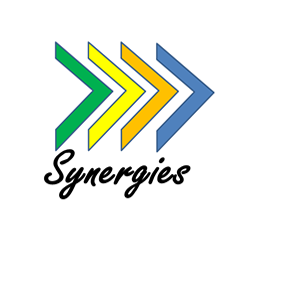 Example 1: Synergies Example 1: Synergies
This school has used the diversity of student profiles to develop a linguistic culture and strengthen the diversity of languages taught. For this, the school used the mobility projects, cultural spaces, different classes and school sections, in particular an American international class and a special class for allophone students. It is about strengthening every learner through the diversity of profiles. The project has enabled the expansion of languages offered through the introduction of Turkish as a foreign language.
Collège Vauban, Belfort, France |
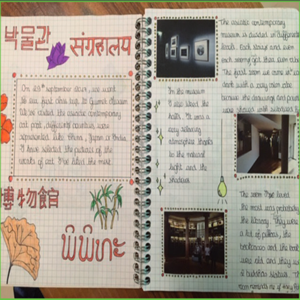 Example 2. Highlighting literature and linguistic studies Example 2. Highlighting literature and linguistic studies
In this school, languages such as Russian and Japanese are considered just as important as English, Spanish and German to promote the language pole. The project has expanded to other disciplines (French, history and geography, mathematics). Created to revitalize and highlight literature and linguistic studies, the project is spreading to the Year 11 students where the future linguists are.
Lycée des Sept Mares, Maurepas, France |
| Example 3: Planning tool
Sustaining the diversity of languages requires regular appreciation of all languages and the diversification of approaches, organisations, projects and strategies. Here is an example of a planning tool that addresses these goals.
|
|
3. Interculturality
Experience dimension |
|
|
|
|
| |
| FOR |
- Tandem with school partners
- Immersive, intercultural use of language ; language learning through mobility, immersion and intercultural mediation |
|
| THROUGH |
- Intercultural competencies
- Democratic culture, sense of alterity |
|
| EXAMPLES |
 Example 1: Rucksack-library Example 1: Rucksack-library
Students bring home a backpack containing books. They choose one they would like to read and replace it with one of their own books. They then bring the backpack to school so that it can be handed over to another student. This approach promotes cultural exchanges between students and families. This principle also works with foreign partners.
|
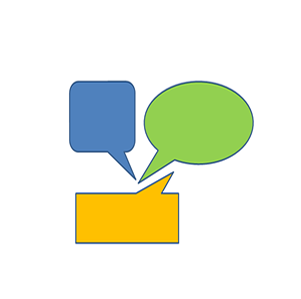 Example 2: Foreign language assistants Example 2: Foreign language assistants
Foreign language assistants play a vital role in the development of language learning environments. The Language Assistants program in France for example involves 4,500 young people from 60 countries and 15 language areas who support the teaching of languages and cultures in primary, middle and high schools. Their contract lasts from 1st October to 30th April. Their presence in the school is particularly suitable for projects with pupils and the teaching staff.
|
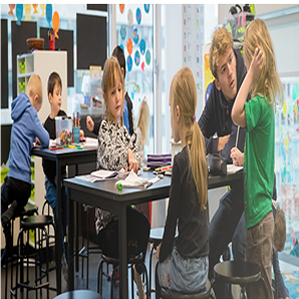 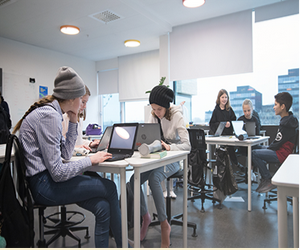 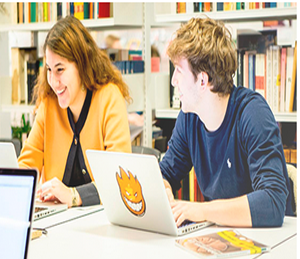 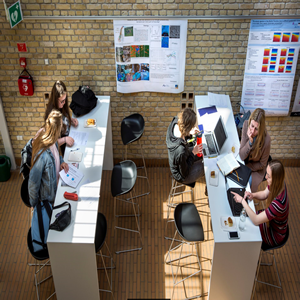 Example 3: Collaborative learning – Aarhus, Denmark Example 3: Collaborative learning – Aarhus, Denmark
Learning with others is at the heart of educational practice in Denmark. The attitude of teachers, the geography of classrooms, the choice of classroom furniture, the use of mobile digital tools and the priority given to the project-based approach nourish a collaborative culture from primary school to training students and future teachers. Learning as much as teaching is firmly anchored in the logic of investigation that generates the collaboration of the actors and makes young people capable of social and professional integration. This pedagogy is particularly relevant to the teaching and learning of modern languages.
|
| FOR |
- Language learning through arts: music, literature, paintings, photography, etc. |
|
| THROUGH |
- Artistic and cultural education
- Transcendence,going beyond one’s limits |
|
| EXAMPLES |
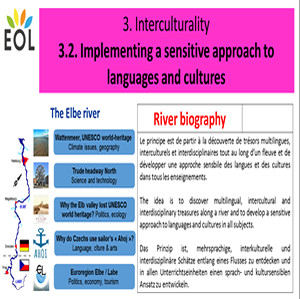 Example 1: River biography Example 1: River biography
The idea is to discover multilingual, intercultural and interdisciplinary treasures along a river and to develop a culturally and linguistic sensitive approach in all subjects.
|
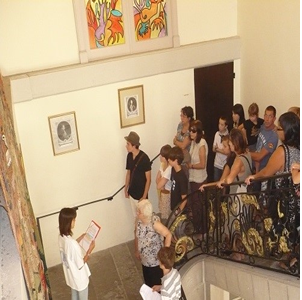 Example 2: Heritage and plurilingualism Example 2: Heritage and plurilingualism
The goal is to make pupils aware of Carcassonne's heritage. Guided visits by the pupils are provided during the European Heritage Days with the participation of "bilingual student guides".
Carcassonne, France |
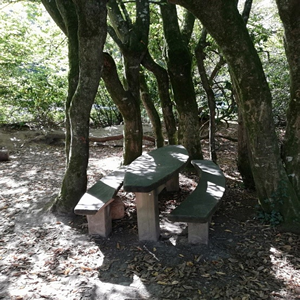    Example 3: In the deep forest Example 3: In the deep forest
The forest is the dream theatre for learning and education. The forest is in many cultures a strong feature that is found in literature, painting, music and traditions. But it is also a particularly good place to discover mathematics and science, especially biology, ecology, economics, etc. Bring the students to the forest to discover through biodiversity the variety of sounds of a language they are learning, have them calculate the height and age of trees in a foreign language, offer them an orienteering course in which the clues solicit their entire plurilingual repertoire or offer them poetry readings in this exceptional acoustic environment. All of this constitutes a unique educational experience that accelerates the learning process at the same time.
|
| FOR |
- Partnership and cooperation
- Individual and collective mobility programs
- Incoming and outgoing mobility |
|
| THROUGH |
- Democratic Education
- Empathy and sense of alterity |
|
| EXAMPLES |
 Example 1: Tracking the papa* Example 1: Tracking the papa*
This project aims to establish an international school network to trace the route of this tuber originating from South America and evaluate its impact on European cultures and gastronomy. Students in international groups search for texts, stories, recipes, etc. about the “papa" and gather the information on a collaborative blog.
*Quechua designation for potato |
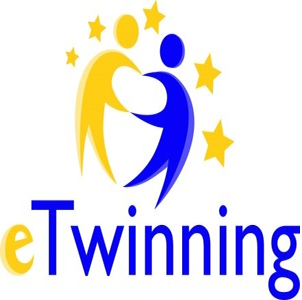 Example 2: eTwinning interdisciplinary projects Example 2: eTwinning interdisciplinary projects
eTwinning enables teachers and students to implement interdisciplinary projects by communicating and collaborating with their European counterparts. An eTwinning project involves two or more different European countries, with the possibility of inviting other partners from Europe or third countries. Projects can be initiated at any time of the school year and in any language. Their duration and the contents are left up to the choice of the participants.
Lycée Freppel, Strasbourg, France / Partnership Strasbourg-Bremen
|
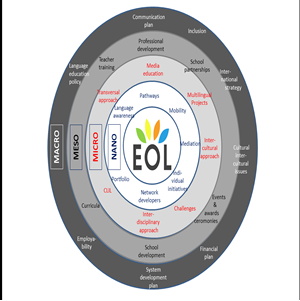 Example 3: European school networking for school development and quality assurance Example 3: European school networking for school development and quality assurance
One of the initial objectives of the EOL project was to found a European network of schools that develops high quality learning environments for and through languages. More than 100 schools from 16 countries have participated in the collective reflection. Now it is a matter of extending the work by collectively improving online tools and resources. Networking must not only promote school development but also guarantee the quality of education.
|
| FOR |
- Widening the offer for professional development through partnerships |
|
| THROUGH |
- European integration
- Singularity and Solidarity |
|
| EXAMPLES |
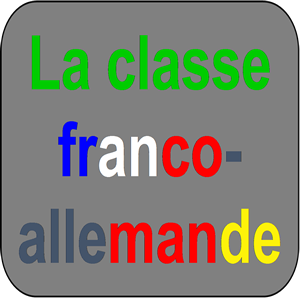 Example 1: Tandem classes Example 1: Tandem classes
French and German students discover their partner's language by working together on an online platform. They also learn to value their own language and culture by accompanying their correspondent. Students seek teaching materials (music, film, etc.) and create challenges for their partners.
Académie de Rennes – Brandenburg |
 Example 2: Digital resources Example 2: Digital resources
E-lang is a project of the European Centre for Modern Languages (ECML) of the Council of Europe. It is about enabling pupils and language users to go beyond their limits by using digital resources and become learners and autonomous users. For written production, e-lang provides examples of real-life tasks in which learners/users experience a participative travel guide.
https://www.ecml.at/ECML-Programme/Programme2016-2019/Digitalliteracy/tabid/1797/language/en-GB/Default.aspx |
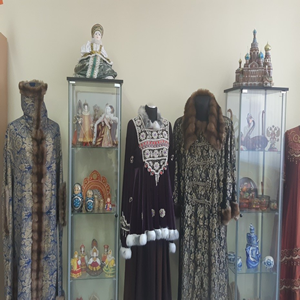 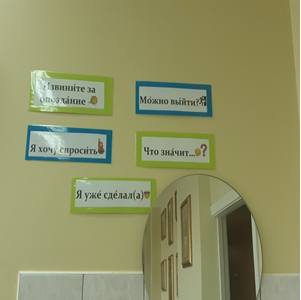 Example 3: Immersion Example 3: Immersion
Inclusion can also be immersion. The classroom is often the first contact of students with a foreign language. It must be for the students an invitation to travel, a space of imagination, a time of immersion in the target language and culture. Different Russian national dresses and other things form the cultural background here.
Russian classroom in Lithuania
|
|
4. Enriching curricula
Curricula based dimension |
|
|
|
|
| |
| FOR |
- One’s plurilingualism
- Other people’s plurilingualism |
|
| THROUGH |
- Reflexive skills
- Self fulfilment |
|
| EXAMPLES |
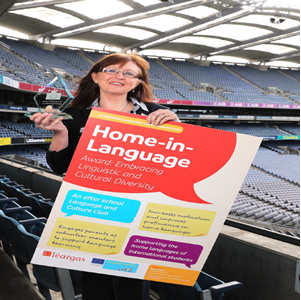 Example 1: Home in language club Example 1: Home in language club
In this school, the development of a "language and culture club" has helped to enhance students' family languages and gradually integrate them into formal education. Valuing linguistic diversity accelerates social inclusion and cohesion.
Maynooth post primary school, Ireland |
 Example 2: Autobiographical booklets Example 2: Autobiographical booklets
Each pupil in Year 9 wrote various autobiographical texts in the different languages practiced not only in the school but also outside. Each language teacher proposes to work on various productions: autobiographical pact, "I like / I do not like", Proust's questionnaire, photo-language, "I remember", summary of a book / film, account of experience or travel, sad / cheerful memories of childhood, Chinese portrait, etc.
École européenne de Strasbourg, France |
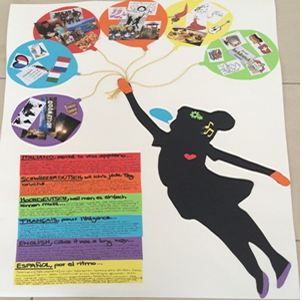 Example 3: Multilingual silhouette, St. Gallen – Switzerland Example 3: Multilingual silhouette, St. Gallen – Switzerland
This outcome was created during a cross-linguistic event at the University of Education in St. Gallen. The students deal with their own multilingualism. To do this, they create a silhouette and thereby make their multilingualism visible or assign the language (s) to a body part. In addition, they write a short legend in which they learn language acquisition principles and language learning methods. Two years later I return the product to the students and in a self-confrontation they have to explain the silhouette and at the same time I want them to explain what has changed in recent years regarding multilingualism (didactics) as well as representation and attitude towards multilingualism. The reflection should lead to students later at work to recognize their learners as multilingual learners as well as opportunities and possibilities of multilingual approaches as well as planning / enabling multilingual learning environments.
|
| FOR |
- Interdisciplinary projects / team-teaching
- Integrated (CLIL) or bilingual teaching
- Immersive or language sensitive learning |
|
| THROUGH |
- Working / training on projects
- Initiatives and entrepreneurship |
|
| EXAMPLES |
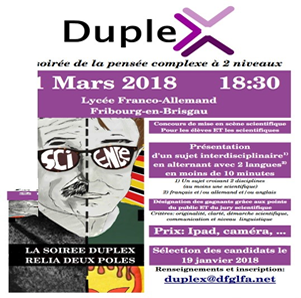 Example 1: E-Duplex Example 1: E-Duplex
E-Duplex is a competition for which students are asked to present in two languages and in less than ten minutes a scientific project. In addition to motivating students, this approach has the advantage of using multilingualism to popularize a scientific approach.
Deutsch-französisches Gymnasium, Freiburg im Breisgau, Germany
|
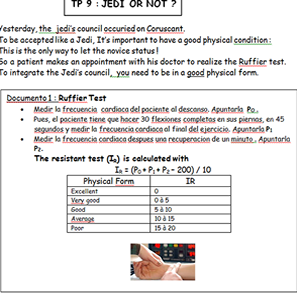 Example 2: Multilingual tasks in science Example 2: Multilingual tasks in science
The professor of physics-chemistry offers their students practical assignments in English, Spanish and French. Students can request the teacher in the language of their choice. The tasks are written by the teacher in one or more languages. Student reports (oral or written, on various media) are written in a foreign language.
Lycée Henri Avril, Lamballe, France
|
 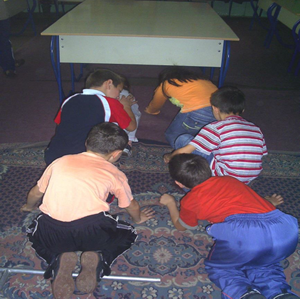 Example 3: Languages and physical education Example 3: Languages and physical education
Studies have shown that physical activity enhances the learning of a foreign language compared to learning it in a static condition. For example, in physical education the activity can be conducted using instructions in a foreign language. Physical activity can be done in class, but the integration of modern languages into physical education also offers great opportunities, especially for discovering other sports related to the countries whose language is being learned.
Collège Henri Matisse, Lille – France / Primary school, Bosnia and Herzegovina
|
| FOR |
- Learners’ progression
- Language bridges
- Lifelong learning |
|
| THROUGH |
- Accepting school rules
- Trust through transparency |
|
| EXAMPLES |
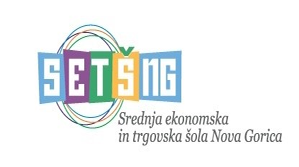 Example 1: Bilingual itinerary Example 1: Bilingual itinerary
By offering all the courses in two languages (Slovenian and English or Slovenian and Italian) this school has developed within the team a common culture of linguistic and intercultural issues. The pupils thus have a real itinerary of continuous training in languages.
|
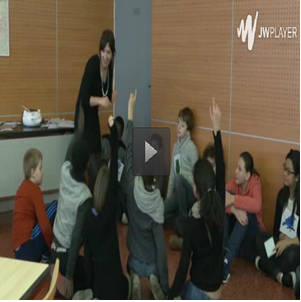 Example 2: Continuity of learning Example 2: Continuity of learning
A common educational project to ensure the link between the primary and middle school cycles. For both classes, it was to participate in a meeting between primary and middle school pupils. The CE2 / CM1 (primary schools) sang "Auf'm Bauernhof" and they participated in games on the theme of animals. The pupils from the 6 th class had organised an animal party at the middle school and prepared some riddles for the other pupils.
Ecole Jules Ferry, Collège Van Gogh, Clichy, France
|
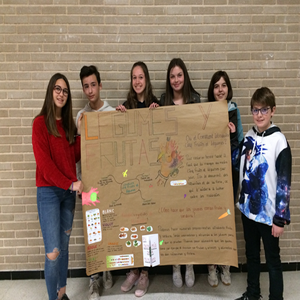 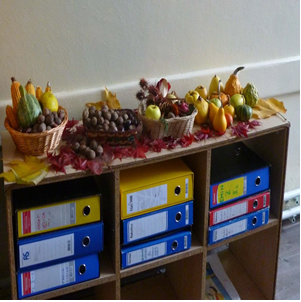 Example 3: Continuity of education Example 3: Continuity of education
Languages are also a great support for extending the learning that has been started in other subjects. Particularly in cross-curricular education, there are many topics that can be enriched by the intercultural perspective that modern languages bring. The two examples here relate to food health education. Making posters for health education with a partner school or discovering flavours from elsewhere is another way to discover the world.
Lower secondary school , France / Primary school, Bosnia and Herzegovina
|
| FOR |
- Teamwork and network
- Linking practice, training and research
- Transferring experience knowledge, expert knowledge and practical knowledge |
|
| THROUGH |
- Social and collaborative skills
- Sense of belonging |
|
| EXAMPLES |
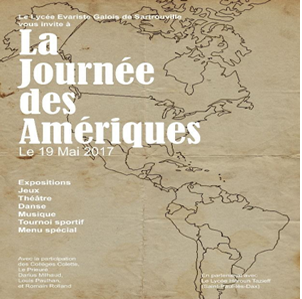 Example 1: Intercultural day Example 1: Intercultural day
To enable middle school students to discover their future high school, the school creates an intercultural event every year that mobilises high school and middle school students , as well as teachers and parents. On this festive day workshops, games, challenges, shows, tastings, etc are organised in all the languages concerned. All disciplines are mobilised. 2017: Day of the Americas; 2018: Europe Day; 2019: Water Day.
Lycée Evariste Gallois, Sartrouville, France |
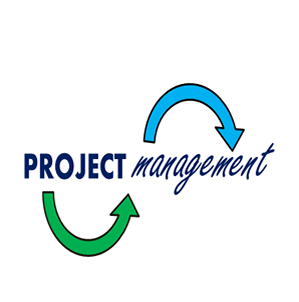 Example 2: Project management Example 2: Project management
After one year of implementation of the EOL project in two sites (lycée de 7 Mares de Maurepas - lycée Evariste Galois de Sartrouville and five middle schools in the sector) the teams of teachers involved wished to benefit from support to help them in the project management, both in terms of management and the use of appropriate tools.
|
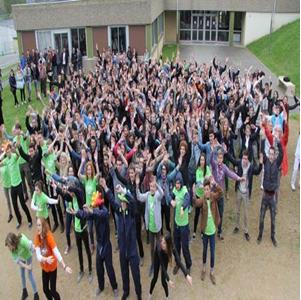 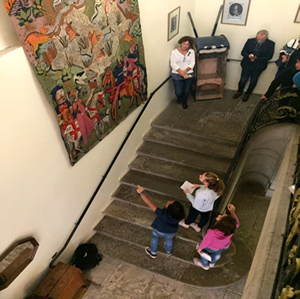 Example 3: Collaborative approach – France Example 3: Collaborative approach – France
Collaborating is more than just adding skills. Collaboration multiplies the opportunities of interaction and creation which helps us discover the world. This can be done spontaneously, for example in the form of a flashmob choreography, but also in a more gradual way, by giving students new responsibilities, for example to guide other students or to guide adults. The Walk & Talk project allows students to enhance their plurilingual repertoire and their cultural knowledge with foreign tourists. This is a typical win-win principle of collective intelligences.
|
|
5. Everyday languages
Existential dimension |
|
|
|
|
| |
| FOR |
- Personal work experience abroad or in an international company or association or equivalent |
|
| THROUGH |
- Training and career advising
- Individual fulfilment |
|
| EXAMPLES |
 Example 1: Olive tree Example 1: Olive tree
In this school, which welcomes an audience of great cultural diversity, the feast of the olive tree has created bridges between cultures. The celebration of this "transcultural" event has strengthened the partnership between parents and the school.
Collège Jean Moulin, Alès, France
|
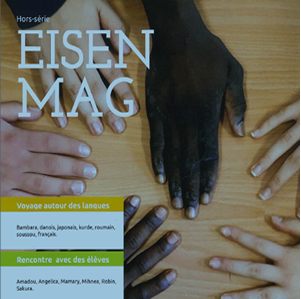 Example 2: Magazine writers Example 2: Magazine writers
A group of allophone pupils participated in the writing of a magazine in which they wrote articles about their country of origin, including words from their mother tongue.
Collège Charles Eisen, Valenciennes, France |
 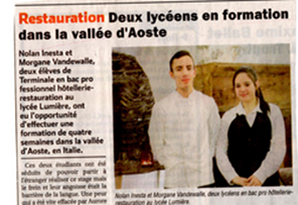 Example 3: Languages and professional training Example 3: Languages and professional training
Mobility is a key to social and professional integration. This is why it is important to combine language learning and vocational learning. The two examples here show how vital the role of language learning is in hotel and restaurant schools: languages make it possible to communicate and enhance the value of one's work, but they also open up opportunities for international mobility.
Lycée Ader, Bernay – France / Lycée Lumière, Luxeuil, France
|
| FOR |
- Combining formal, non-formal and informal language learning
- Flipped Classroom, mobile tools (tablets, smartphones, etc.), BYOD approach |
|
| THROUGH |
- Media skills
- Autonomy, independent
- Ownership, responsibility |
|
| EXAMPLES |
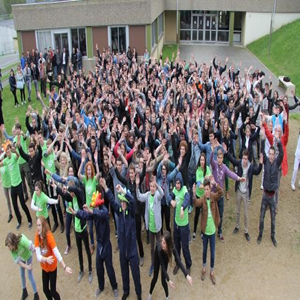 Example 1: Multilingual flashmob Example 1: Multilingual flashmob
By varying the location of language use, this high school has strengthened the language skills of its students and teachers. For example, creating the choreography for a multilingual flashmob involves many interlinguistic exchanges.
Lycée Henri Avril, Lamballe, France
|
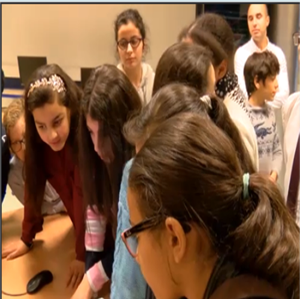 Example 2: The treasure hunt Example 2: The treasure hunt
Pupils search for the hidden treasure by following the treasure hunt created by other pupils. They interact, exchange information, and help each other to find hidden clues together all in Arabic. The out-of-class context and the circulation through different spaces of the school accentuate the attention to the flow and range of the voice and give meaning to this activity.
Collège Lucie Aubrac, Courbevoie, France
|
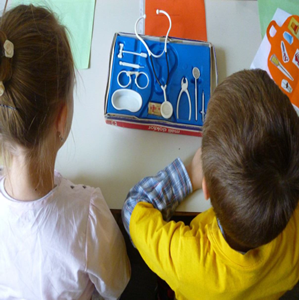 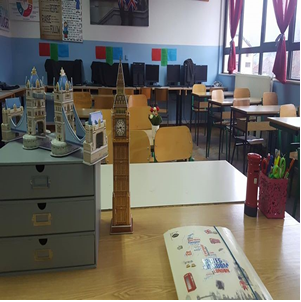 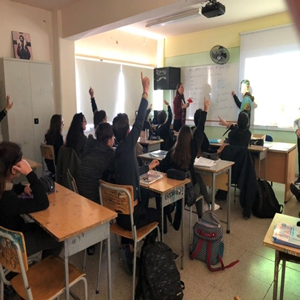 Example 3: Various spaces, various activities Example 3: Various spaces, various activities
Using all learning spaces also means making full use of the classroom to diversify learning methods and materials. In a language class, it is possible to learn a language by listening to or playing music, playing board games or simulating real-life situations, using role plays or by using the wall display to create an environment in which exposure to the target language of learning is increased. This classroom space can also be extended to the digital learning space. The entire class space can evolve according to the learning objectives. The quality of language teaching also lies in the teacher's ability to renew the learning environment and thus to diversify learning situations to respond to the diversity of student profiles and needs.
Healing in English class in Bosnia and Herzegovina / Playing in English classroom in Montenegro / Singing in French class in Cyprus
|
| FOR |
- Languages in town, around the school area
- Languages of school partners: parents, local networks, associations, etc.
- Languages in different learning spaces |
|
| THROUGH |
- Democratic education
- Learner as mediator, ambassador
- Including parents |
|
| EXAMPLES |
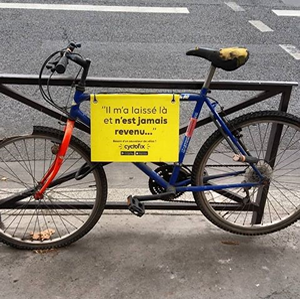 Example 1: Reading the city Example 1: Reading the city
Walking through the city and photographing the urban posters, students will reflect on the linguistic landscape in which they live. Students classify photos to create a visual medium representative of their environment and then share it with partners abroad. The educational objective is to show everything that students have in common with young people from other countries and nationalities.
Marisa Cavalli et Claude Cortier – Langues régionales / minoritaires dans l’éducation bi-/plurilingue – Langues d’ici, langues d’ailleurs, CELV, Graz, 2013 |
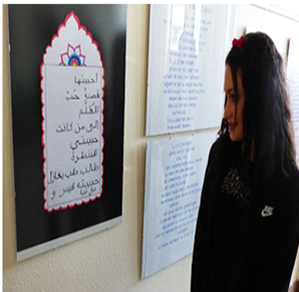 Example 2: Other voices Example 2: Other voices
Russian, Creole, Berber, Malagasy, Portuguese, Tibetan or Arabic: more than thirty languages are present in the high school. At the initiative of the project, teachers Menouba Ahchouch and Thierry Cattan, wished to highlight this linguistic landscape. The student volunteers were accompanied by actor Jean-Pierre Brière, with whom they worked on oral and speech techniques. Then everyone recorded their production with sound specialist Franck Dubois. The audio recording includes songs, texts, poems, or personal productions, chosen by the student (often with their family). The recording was broadcast at the beginning of the day, in the central courtyard of the school.
Lycée Aristide Briand, Évreux, France
|
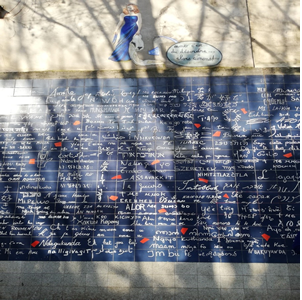 Example 3: I love you – Paris Example 3: I love you – Paris
Expression walls are an excellent interface to visualise the diversity of languages and cultures. In Montmartre you can find the famous “Je t’aime” Wall. The declarations of love are written in more than 300 languages. This area attracts many tourists. It is quite conceivable to transfer this idea to sharing values by using all the languages and cultures in the educational community. This wall can also be produced digitally through an interactive poster that is shared with all the partner schools.
|
| FOR |
- Supporting language diversity
- Linking languages and cultures |
|
| THROUGH |
- Environmental consciousness
- Eco-systemic commitment
- Global citizenship |
|
| EXAMPLES |
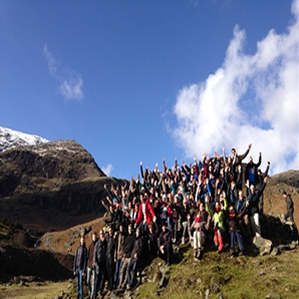 Example 1: Languages in action Example 1: Languages in action
In this Erasmus+ project, the idea here is to explore nature in Europe to collect data as part of a science project on life on Earth. For example, this has allowed students to discover with partner students the properties of Aloe Vera in the Azores archipelago. The school has developed partnerships in Portugal, Iceland, Germany and the Czech Republic and has created LINOit, an online multilingual environment for science.
Lycée Félix Le Dantec, Lannion, France
|
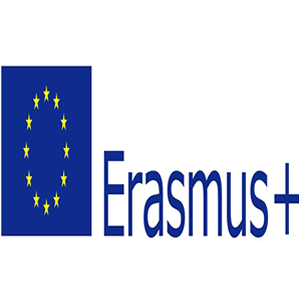 Example 2: Erasmus+ Example 2: Erasmus+
The European Erasmus + programme offers many opportunities for mobility and training for pupils and staff of public or private schools, general, technical or vocational education, from kindergarten to high school.
|
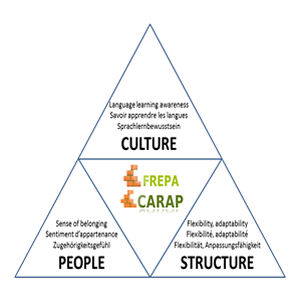 Example 3: FREPA - How can the FREPA contribute to build a multilingual environment? Example 3: FREPA - How can the FREPA contribute to build a multilingual environment?
On the FREPA website you will find many examples that show an immediate link between the individual multilingual and multicultural competence and the multilingual environment. This triangle gives an idea on the reciprocity. “Pluralistic approaches to languages and cultures (Language awareness, Integrated didactic approaches, Intercomprehension between related languages, Intercultural approaches) are based on activities that include several linguistic and cultural varieties. They develop a concrete concept of the multilingual and multicultural competence promoted by the Common European Framework of Reference for languages. They provide tools which allow for the design and bringing together of didactic interventions favorable to the development and continuous enrichment of this competence by learners. Dedicated to plurilingual and pluricultural dimensions of learning, FREPA complements the other instruments of the Council of Europe.”
https://carap.ecml.at/Keyconcepts/tabid/2681/language/en-GB/Default.aspx
|
|